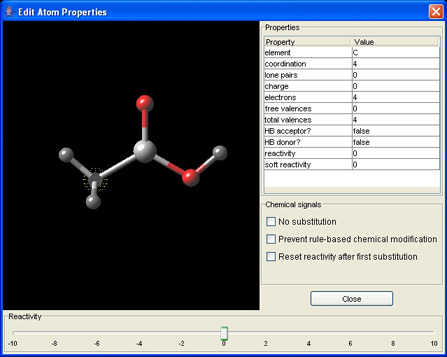4. Reactivity Adaption and the Atom Reactivity Editor
4.1. ilib diverse's chemical reactivity management
ilib diverse possesses a powerful chemical reactivity management system that allows the user to adjust the reactivity of every atom and bond of a fragment. ilib diverse distinguishes between the user-adaptable priority reactivity and soft reactivity.
Priority reactivity strictly creates a prioritized atom list for each compound. If extensively used, this parameter completely destroys structure diversity. As a default value, every atom has a priority reactivity of 0. The atom reactivity editor allows the user to adjust the reactivity value for each atom in the range from -10 to +10. ilib diverse automatically changes this value when reading fragments at startup only in two cases: i) if the atom is part of a feature, priority reactivity is set to a negative value [heteroatoms are set to -2, carbon atoms to -1], and if the atom is a nitrogen atom adjacent to carbon atoms with at least one free valence, setting priority reactivity to 1 is preferred.
Apart from setting priorities, the drug-likeness of the results can strongly be improved by creating a trend reactivity. The idea behind soft reactivity is that the kind of combination ilib diverse uses mostly resembles nucleophilic substitution. So, the electronegativity difference between an atom and its neighbors has been taken as a hint for slightly weighed preference.
The selection of atoms with different soft reactivity values is implemented as follows: For a number of atoms with the same priority reactivity, an atom is chosen at random. If this atom's soft reactivity value is higher than 0, it is selected for molecule generation. However, if this value is lower than 0, probability of the atom to be eventually selected falls to 30%. For the remaining 70% of the cases, another random choice is started (including the current atom).

4.2. The ilib diverse atom reactivity editor
For defining the reactivity of the currently selected
fragment,
click on the
![]() icon to
start the atom reactivity editor.
icon to
start the atom reactivity editor.
The atom property view of the reactivity editor displays the following properties:
- element: atom type
- coordination: number of adjacent atoms
- lone pairs: number of electron pairs
- charge: number of charges
- electrons
- free valences
- total valences
- HB acceptor: number of H-bond acceptors
- HB donor: number of H-bond donors
- reactivity: priority reactivity (user-adaptable)
- soft reactivity: trend reactivity
The navigation in the editor is same as in the fragment detail view. Select an atom or bond of the displayed fragment to activate the reactivity options panel to the right. By dragging the arrow on the reactivity scale control the priority reactivity of the selected atom/bond.
Press the T key to activate the transparent mode. This display mode is used to view the priority reactivity of the atoms.
Highly reactive atoms are colored green, less reactive atoms are colored red.
Suspend subsitution of specific atoms by selecting the No substitution option to the right. These atoms are depicted in glaring red color.
The prevent rule-based chemical modification option flags atoms that must not get chemically modified. These atoms are displayed in blue. For further details on the rule-based chemical modification see chapter 5.2.
Selecting the Reset reactivity after first substitution option sets the priority reactivity of the currently selected atom back to 0 after the first substitution has been executed. This option is very useful e.g. to avoid further substitutions at this atom.
